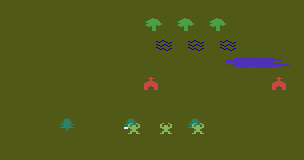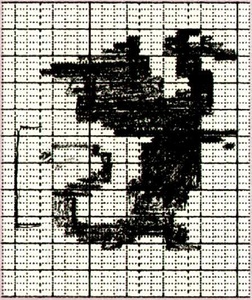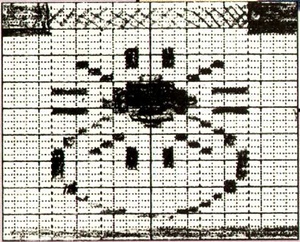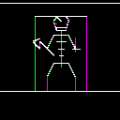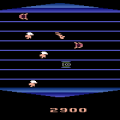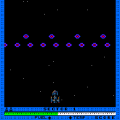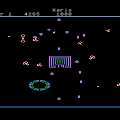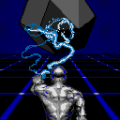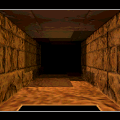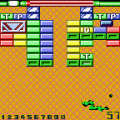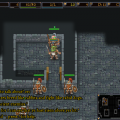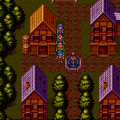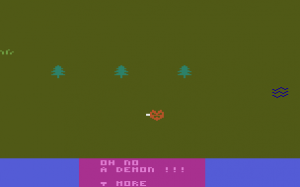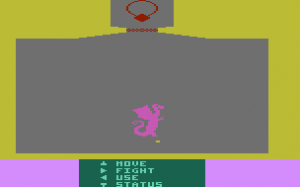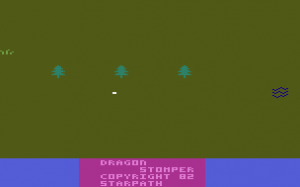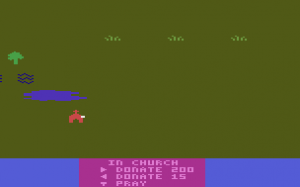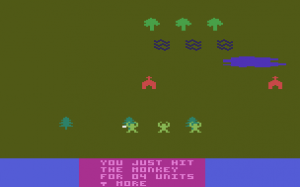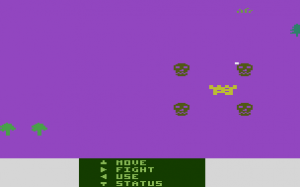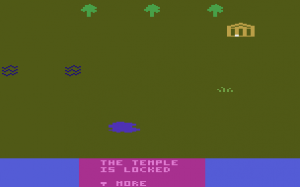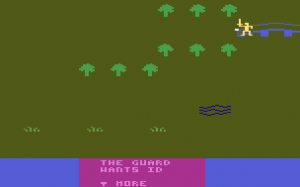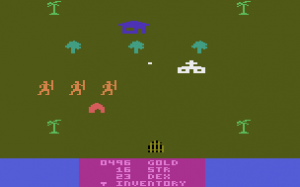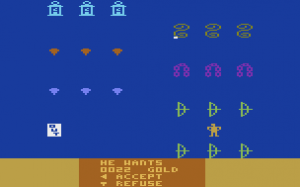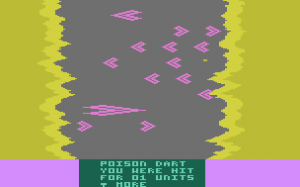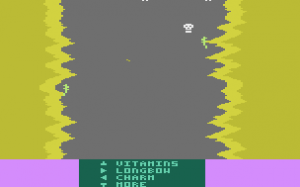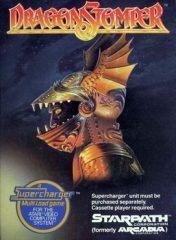
Cover
If you ask RPG fans what the original console RPG was, odds are most will tell you it was 1986’s Dragon Quest. While it’s true that it established the template most console RPGs would soon follow, it’s far from the first. To see the beginning, you have to look back four years earlier, when the Atari 2600 still ruled, a year before the crash that would put console gaming in the US in hibernation. That’s when DragonStomper was released, a game that, while primitive, manages to actually be surprisingly similar to games that would follow years later.
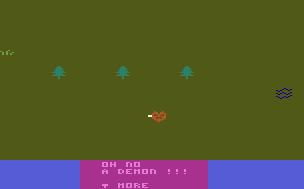
There was also a first-person RPG on the 2600 in the same year, Crypts of Chaos, as well as Mattel’s Advanced Dungeons and Dragons for the Intellivision, but nobody knows which game came first. The magazine Electronic Fun reviewed AD&D in its February 1983 issue, DragonStomper in March, and Crypts of Chaos in June. At any rate, DragonStomper is clearly the most ambitious of the three, and the one where the RPG formula remains the most recognizable.
DragonStomper was designed and programmed by Stephen Landrum, who modeled it after the Dungeons & Dragons experience, when he was only 20. You might think an RPG would be far beyond the 2600’s humble capabilities, and it actually kind of was. To play DragonStomper, you’d need the Starpath Supercharger, an accessory to play games from cassette tapes. The Supercharger added 6 KB to the consoles RAM, a massive upgrade for the time. For a clear example of just what the Supercharger could do, compare the cartridge version of Frogger with the version made for the Supercharger:
While the extra memory led to twelve games with capabilities well beyond 2600 cartridge games, DragonStomper is definitely the most impressive of them, just for what it is. It’s somewhat surprising that it hasn’t become famous among retro gaming circles, although there are many reasons for that. It might have gotten lost in the glut of games for the 2600 that eventually led to its downfall in the US, or the need for an extra accessory meant that later Atari fans didn’t come across it as easily.
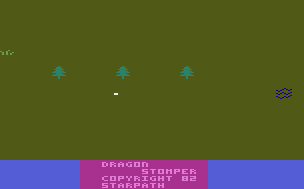
As an RPG from 1982, the plot isn’t particularly amazing. The manual goes into further detail on the backstory – there’s a dragon, it’s being a jerk by sending monsters all over the kingdom thanks to the magical amulet it has. As the Dragonstomper, baddest white dot in the land, you have to get the amulet back. Killing the dragon is, surprisingly, optional. None of this is communicated in the game itself, which only uses text when absolutely necessary.
There are only two types of characters that could be described as NPCs – a guard on the bridge and village warriors who complain if you stand in their way. It makes for a somewhat lonely experience, and if you’re really using your imagination, you can really begin to feel like you’re completely alone, surrounded by creatures who want you dead, and where no one, not even the local deity, care about you beyond your money.
The game is split into three distinct sections: The wilderness, which serves as the game’s overworld, a village with a few shops to spend your gold, and the dragon’s cave. It’s pretty linear, compared to games like Ultima. Once you enter one area, there’s no going back. It may be an RPG, but it’s still an Atari game, which means that if you know what you’re doing, you could probably clear the game in about twenty minutes or so, and that’s being charitable. That feeling of dread and oppression isn’t for nothing, however, because the game will do just about anything in its power to hinder and frustrate you, as was the style of RPGs at the time.
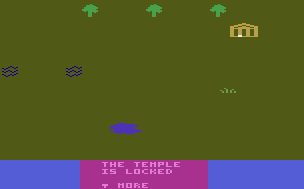
In the wilderness, your goal is to find a way past the guard blocking the only bridge into town. You’re actually given a few options on how to approach this, and while only one is really a good idea, it’s still kind of a surprise for a game this old. You could fight the guard, although he’s one of the tougher opponents in the game. Giving him gold isn’t a very attractive option, either, given how badly you’ll need it later on in the game. What you really want to do is find an identification scroll, either in a glowing castle on the map or randomly dropped by enemies, and then bring it back to the guard to save yourself a lot of trouble.
While you’re wandering in the wilderness, you’ll find an assortment of objects to interact with, like trees, castles, temples, and huts. Bumping into one of these with your dot has a chance of revealing an item or an enemy encounter. You also find traps around castles on the map, which are usually invisible until you bump into one and take damage. While the layout of the map is the same in each session, what you find when interacting with objects changes every time you boot up the game. So if you touch a tree and get into a fight with some monkeys, every time you reset, that tree will always have monkeys until you turn off the system and start it up again.
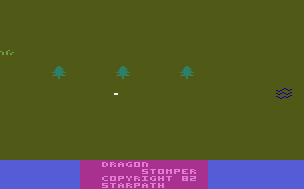
Enemies include slimes, golems, “maniacs”, and spiders, but aside from their sprites, they’re all mostly identical. Your Strength stat serves as your hit points, and also supposedly determines how much damage you can do. In practice, however, damage outputs are generally random, and skewed far more in the enemies’ favor. You also have Dexterity, which supposedly effects how often you hit enemies and avoid attacks, but it’s similarly vague in how much it actually helps. There’s no experience or leveling up, so the main reason to fight enemies is to take their money, along with the occasional item they drop.
Two of Stephen Landrum’s graph paper sketches for the enemy sprites (from Electronic Fun 2/1983)
Most items are a gamble at best, since their effects are randomized every time you boot up the game. So if a cross enabled you to see hidden traps one time, the next time it might drain your Strength or Dexterity instead. The game itself won’t tell you this, and only gives a cryptic message that it “FEELS WEIRD”. Then you have to check your status manually and hope that the game actually raised your stats. Magical items are the only way to gain Dexterity in the wilderness, but at least they’re the only way to lose it, too. You also find keys that open locked buildings or chests you might come across, and shields that apparently don’t do anything but give the programmer’s initials in certain circumstances, among other things.
You can also spend your money at churches for the chance of being healed, which happens so infrequently that it’s almost a total waste of gold. You can also pray, which has the game print out “NO EFFECT”, the same thing you get if you don’t get healing. You have to wonder if the programmer was trying to imply something with that. You can also regain strength naturally over time, although this is so slow that you’ll probably be attacked more than once before you get any appreciable amount of strength back. It doesn’t matter if you’re standing still or moving, if monkeys want you dead, they will find you. Really, the best thing you can do is get the identification scroll and go to the village as soon as you possibly can. This is not a game for those who love to grind, since just a couple of bad enemy encounters can easily kill you. At the very least, dying in the overworld isn’t much of a punishment, since it just respawns you where you died, without all your items, but resetting you back to your initial amount of 400 pieces of gold.
Once you have a way to get past the guard and you’re certain you have enough gold, you can move into the village. Going by the sprites of the trees and the sound effects, it’s apparently always caught in a Class 5 hurricane. The main purpose of the village is to buy things for your trip into the dragon’s cavern, like healing items, magic scrolls of varying effects, and warriors that you can pay to be your meat shields against the dragon. Once you approach the gate to the cave, the game will let you know that there’s no going back, so make certain you’re ready.
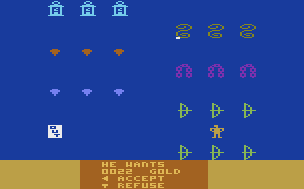
The cave itself is one long hallway, with no enemies to be found. Instead, you have to deal with a gauntlet of traps, most of which are invisible unless you happened to buy the scroll that lets you see them – only for a few seconds, of course, because 1980s RPGs hate you. You also have to navigate rows of poison arrows In real time. And these arrows go so fast that no human reflexes will let you avoid them, so you better carry a medicine item or two. If you get past that and reach the pit that leads to the dragon’s lair, you’ll definitely want to make sure you brought a rope with you, or the trip down is going to hurt you, too. It’s as if this accessory was made just to fit more hate into the game.
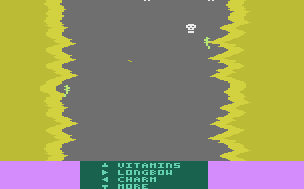
The dragon itself makes a decent final boss, and the game offers more tactics for fighting him than any of the other monsters you encounter. He even chases you around his room, should you attempt to escape, which makes using warriors to distract him a good tactic. And you’ll want to make use of any option you have, given how tough it is to actually get here. If you have enough items, however, and you’re fast, you can actually move past the dragon and steal its amulet, instantly winning the game without actually having to kill it. (The manual implies that the dragon will be rehabilitated, although this doesn’t change the ending you get.) Again, having an alternate solution to an obstacle presented to the player is actually pretty surprising to see in a console game in 1982, even if both routes are just about as hard.
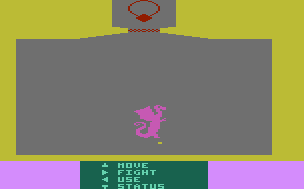
The graphics are decent, considering the hardware. Not much in the way of color, but the fact that the game uses so many unique sprites for enemies is a nice touch. The highlight would have to be the dragon itself, a rather massive sprite that actually animates on screen. (And it doesn’t even look like a duck, either, so it has that over the dragon from Adventure.) The game also makes use of snippets of public domain music, like the Funeral March whenever an enemy dies. (Not usually something you expect to hear when you win a fight.) It’s definitely a lot more creative than the typical use of sound in most Atari games, at least.
Despite its sadistic level of difficulty, DragonStomper represents a massive achievement for the humble Atari 2600. It’s been forgotten in gaming history for the most part, which is a huge shame. While it can’t offer as much content as home computer games of the time, like Ultima or Wizardry, there’s still some interesting ideas hidden in there. After 1982, there would be no other RPGs released for an Atari console until Towers II on the Jaguar, 14 years later. It’s a game that’s a complete anomaly in its existence, but one that still deserves to be remembered.
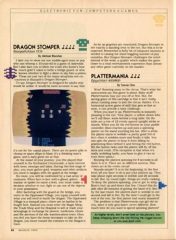
Review in Electronic Fun 3/1983
